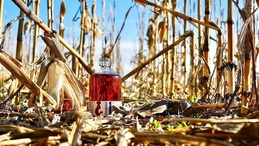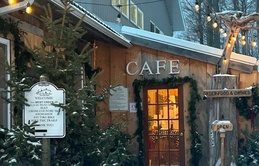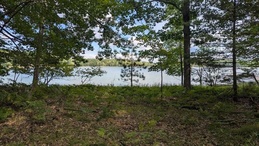Michigan's Kirtland's Warbler
May 17, 2015

A Rare Bird, Indeed
"They come from all over the world to just catch a glimpse of the Kirtland’s warbler, considered one of the rarest birds in the world," explained U.S. Fish and Wildlife biologist Chris Mensing, as he prepared to lead me and a small group of others in search of the elusive bird in Grayling a few years ago.
As I later learned, I was almost as rare in that setting as the little warbler we were trying to find.
"I’ve been conducting these tours for years and I’ve had only a few people from northern Michigan in attendance," he laughed. As it turned out, the others on our tour were from the state of Washington, Washington D.C. and Canada.
These demographics haven’t changed much, said Wendy Tatar, program coordinator for Michigan Audubon Society, which now conducts the daily tours from Hartwick Pines State Park from May 15 through July 4.
"I just got an email from someone in Japan requesting information on the tour dates," she related. "Just in the last few years, since the Audubon Society took over the tours, we’ve had over 1,000 people come from 41 states, Canada, Puerto Rico and five foreign countries, but not many from the local area taking the tour."
In 2005, the Audubon Society began assisting with the tours and, a few years ago, took them over exclusively.
The bird’s primary breeding grounds are the Jack pine forests of northern Michigan. A few are found in the Upper Peninsula, Wisconsin and Ontario. The elusive warbler was first discovered near Cleveland in 1851 by noted Ohio naturalist Dr. Jared Kirtland’s, but its nesting range wasn’t known until the turn of the previous century, when a pair of trout fishermen heard an unfamiliar bird singing in the Jack pine barrens along the Au Sable River. Naturalists then determined the rare bird’s nesting habits, which explained why it nearly disappeared 50 years ago.
"It nests only in young Jack pine plantations that have numerous, small grassy openings," explained Tatar. "They will only nest in trees that are between 5 and 16 feet tall, when the tree is between 8 and 20 years old. The warbler is very particular and they abandon the area after they go over 16 feet. That almost led to its demise."

In the past, large tracts of Jack pine forest would regularly succumb to wildfires often started by lightening. This led to a constant regeneration of trees for the warblers’ breeding grounds. Man’s prevention of wildfires in the latter half of the last century meant fewer new jack pine forests were being created.
"In the 1970s, it was discovered that there were probably only about 300 left in the world. It was one of the first birds to be listed as endangered after the Endangered Species Act of 1973 was passed," Tatar explained.
Today, the National Forest Service and the DNR are creating large tracts of suitable Jack pine forests through intensive forest management; about 150,000 acres have been designated for the purpose in the sandy highlands east of Grayling. It’s managed on a 50-year rotation that keeps roughly 30,000 acres of favorable Kirtland’s’s warbler habitat available at all times.
DNR, U.S. Fish and Wildlife Service and National Forest Service employees routinely count the Kirtland’s’s warbler every few years, situating themselves in their habitat and listening for the males’ singing, which can be heard more than a quarter-mile away. They count in quadrants, with volunteers in the field early to count the songs. The last census, performed in 2012, counted over 2,800 Kirtland’s’s warblers nesting in northern Michigan. The number of singing males counted is multiplied by two to include the female, which doesn’t sing.
"The restoration efforts have been successful and people on the tours love seeing the small, blue-gray warbler with its bright yellow breast, and hearing its powerful song. Because it’s so rare, they get really excited when one or more are spotted," added Tatar. "Normally we have had good luck finding warblers, but not always." The Kirtland’s warbler, which visits only Michigan each season, is here for only a few months each year. The males arrive first, between May 1 and May 18, and the females arrive a week or so later. They winter in the Bahamas and Turks and Caicos Islands, making their way south in September. The best time to see the warbler locally is late May through June.
The breeding grounds are closed to the public. You can drive along the roads, stop and listen for their song, but there is no hiking back into the Jack pine plantations. This can only be done on a guided tour, which takes hikers along the plantation two-tracks.
Daily tours from Hartwick Pines State Park begin at 7am and last for two to three hours. On weekends and holidays, a second tour is available at 11am. No reservations are necessary and participants are encouraged to bring binoculars and spotting scopes. Tours are free, but you need a Michigan recreation pass to enter the state park where the tours begin. Participants are driven to the Jack pine plantations from there.
There’s even been support for naming the diminutive warbler Michigan’s state bird – currently the robin, shared with three other states. In 2003, a group of elementary school students visited the state capitol to lobby for naming the Kirtland’s warbler our state bird, but, thus far, the legislature has failed to act upon the request.
For more information on the Kirtland’s’s warbler tours, visit: www.michiganaudubon.org/Kirtland’ss-warbler-tours
HIT THE BIRDING TRAIL
Addendum for additional birding tours and festivals Each spring, hundreds of bird watchers make their way to the northwestern corner of Lower Michigan to enjoy birding activities like those on the Sleeping Bear Birding Trail, an Internet-based 123-mile road map to more than 27 birding sites west of Traverse City, as well as the annual threeday Leelanau Peninsula Birding Festival, held May 28-31.
For more information on the Sleeping Bear Birding Trail and the Leelanau Peninsula Birding Festival, visit www.sleepingbearbirdingtrail.org and www.mibirdfest.com.
Trending

Farm to Glass with Ethanology
When Elk Rapids distillery Ethanology committed to locally-sourced ingredients for their products, it seemed like they&rsquo… Read More >>
MRKT HLDY SHPPNG, aka Warehouse MRKT Holiday Shopping!
Shop the latest from local makers and vendors at the Holiday MRKT Share at Warehouse MRKT in TC, Saturday, Dec. 20, from 10a… Read More >>
Men and Ugly Sweaters
Those two things don’t always go together, but on Dec. 19, you’ll see both out and about in Petoskey and Harbor … Read More >>


